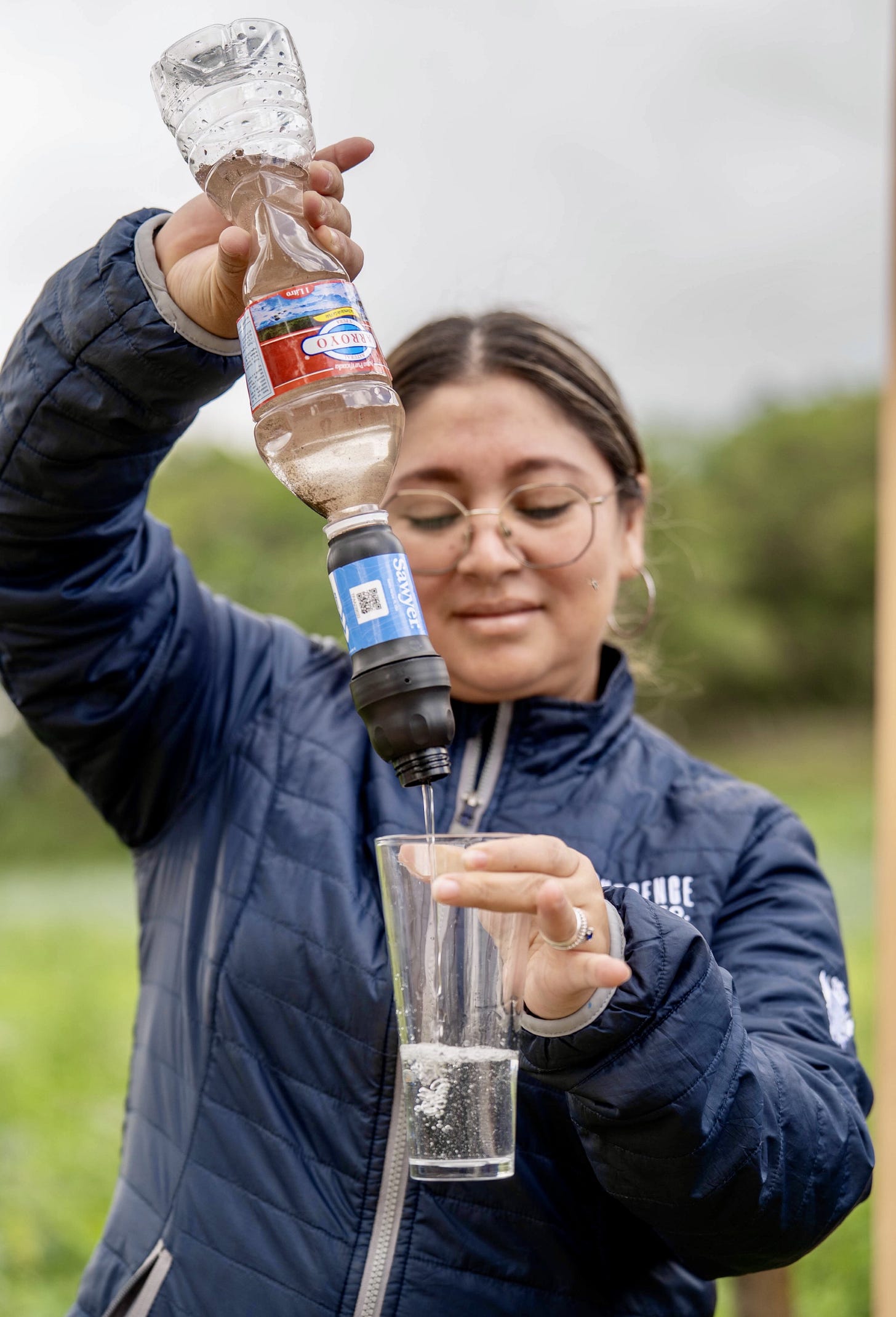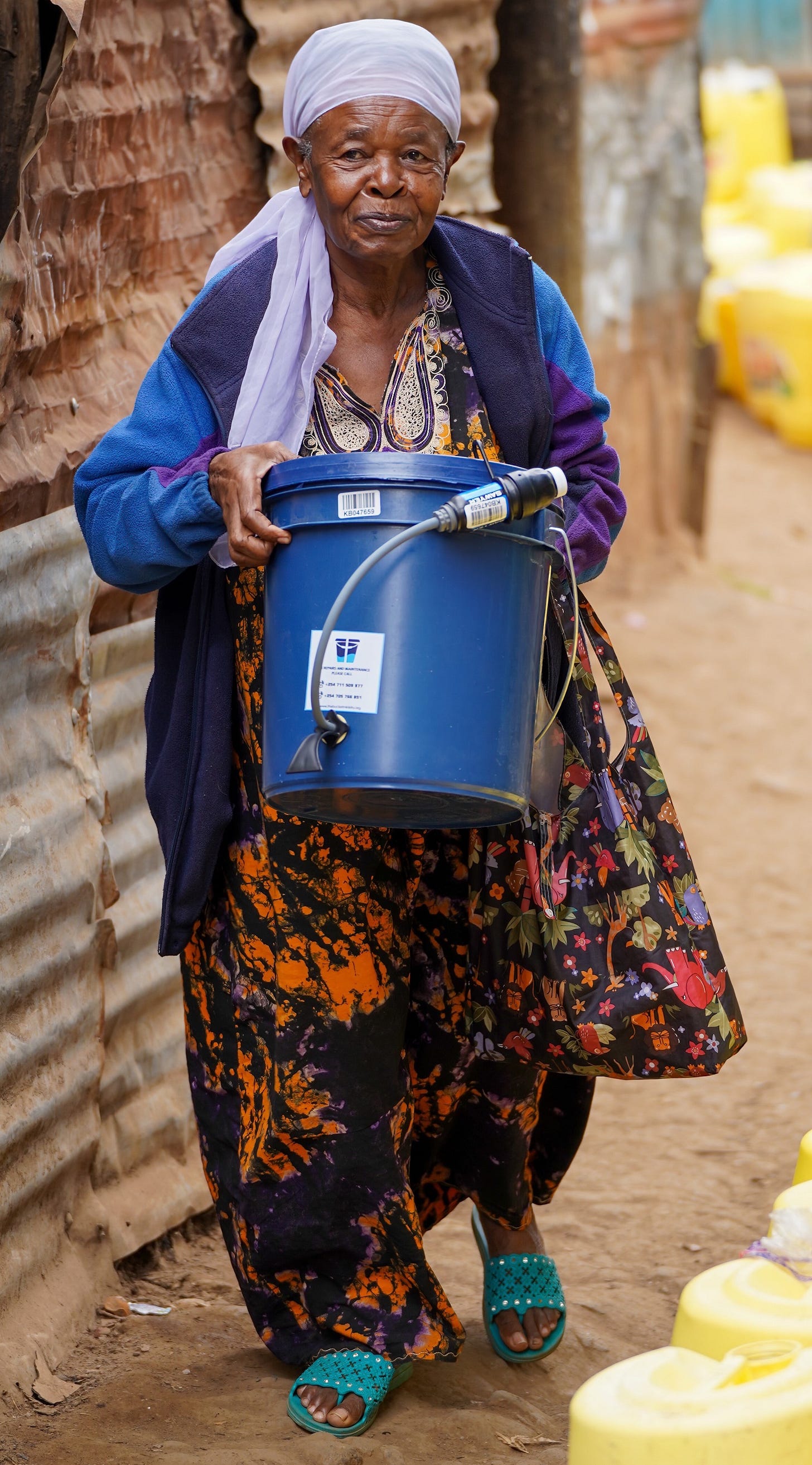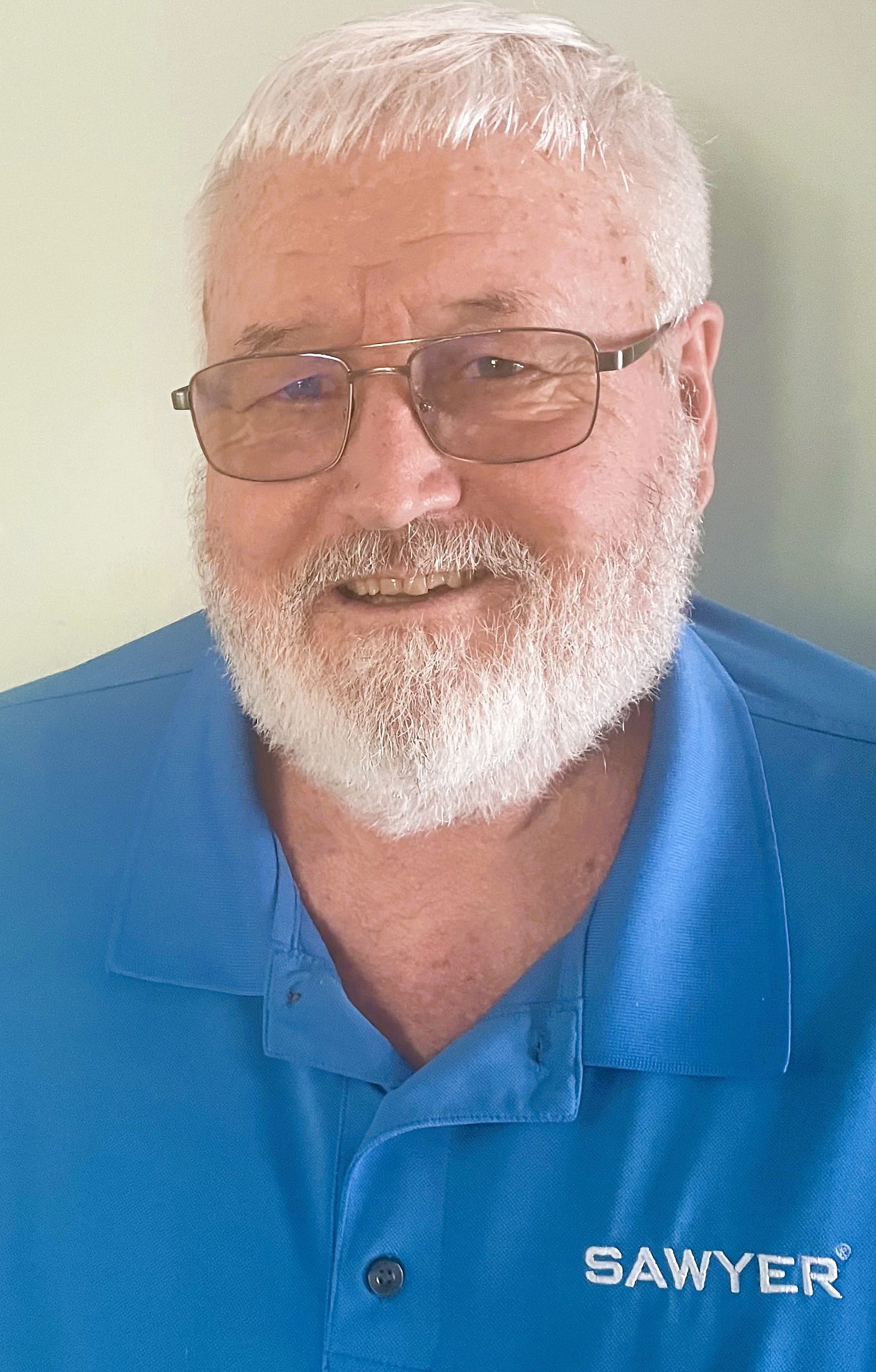
Santo Domingo, Dominican Republic; 2011. As the energetic Americans from Messiah University stood between a pigsty and an opaque, foul-looking pool, the locals were understandably skeptical when Kurt Avery’s allies in the war against dangerous water said they could put an immediate stop to all the young children dying on account of water-borne diseases…
Plus, stop everyone in the village from suffering their entire lives from chronic, excruciating and debilitating diarrhea, cholera, malaria, typhus and skin lesions…
Plus, stop the surviving children from being forced to drop out of school and their mothers from being forced to drop out of the workforce on account of having to traipse 6 or more miles round-trip every day to find and lug 60 pounds of dirty water…
Plus, stop the families from having to spend up to 25% of their meager income to pay for the fuel used to boil the water, that only removed a fraction of the bacteria…
The visitors from Messiah seemed to be saying they could perform a miracle—as if by simply snapping their fingers.
The snorting swine seemed skeptical, too.
When someone asked what would happen were anyone to drink from the putrid run-off, and the community leader answered “You will die,” Messiah’s wrestling coach “just marched over and dug water right out of the muddy puddles the pigs were standing in. Then he proceeded to filter it and took a big gulp in front of everyone. It was,” says Kurt, president and founder of Tampa-based Sawyer Products, the manufacturer of that filter, “one our more shocking demonstrations.”
When I inquired about Kurt’s vision for the future, he alluded to even bigger shocks. “Are you buckled in?”
I laughed. “Yes.”
“In ten years, anyone who needs clean drinking water—will be able to get it.”
“Anyone?”
“Anyone. My mission is simple: clean water for all.”
“But,” I said, “according to the United Nations and others, you’re talking billions of people.”
“Yup. And they all deserve clean water to drink.”
He then educated me regarding the ripple effects associated with providing clean drinking water in these tragic slums and forgotten villages in developing nations: people being less desperate directly translates into less violence; children spending more time in school and their parents spending more time at work boosts GDP by 15-25%, as demonstrated by the scholarly research Kurt has funded.
Artificial Intelligence is all the rage these days. About how it’s disrupting everything from writing and coding to healthcare and manufacturing.
Kurt’s Human Intelligence is every bit as disruptive. But he prefers the term “creative destruction.” (A term coined by the Austrian economist, Joseph Schumpeter.)
Here’s one metric attesting to the scale of Kurt’s creative destruction: according to its annual reports, Charity:Water, the world’s largest clean water NGO, has helped 20+ million; at a cost of about $44 per person. According to Sawyer’s studies—and Kurt is a stickler for accurate data!—he’s helped 28+ million, and he can provide clean water for 10 years; at a cost of about 20 cents per person.
That his solution yields 220 times the bang-for-buck is astonishing enough, but his system has two more big advantages. First, he can “get to market” much faster. As has been been the case for decades, almost all NGOs and governments are still in the business of digging or drilling wells, which involves time-consuming architectural and engineering work, land acquisition negotiations, laying pipes and other infrastructure, etc. Consequently, most clean water projects take months if not years to complete. By comparison—and as has been proven in every major U.S disaster for 10+ years, from Hurricane Helene to the recent Texas floods—Sawyer’s filters can be up-and-running in a matter of hours; typically well before FEMA has arrived. Second, the cost of the aftercare is much lower: the Sawyer filters cost $0 to clean, and anyone can do it, whereas the typical well-based system often requires expensive, time-consuming maintenance owing to the fact that even the most pristine wells are often polluted by animal waste or other contaminants.
Sawyer’s best practices are unparalleled, which is why my wife, I, and several friends recently joined forces with Kurt to tackle the water problem in Ethiopia; also teaming up with one of Sawyer’s most catalytic partners, Kentucky-based Water By Women, in an effort to apply the unique and successful “women-empowerment model” they’ve used in 48 countries to deliver clean drinking water to the 30 million or so who lack it. When I first reached out to Kurt and presumptuously began to educate him about Ethiopia (which I visited in 1995), our aspirations, and the challenges, he interjected: “I know all about Ethiopia. We’ve been trying to do something there for more than a decade. I love the people, too. They have the world’s best smiles.”
The full sweep of Kurt’s inspiring tale is recounted in Sawyer Think. His humble, easy-to-read memoir shares how he’s tapped and leveraged his extremely impressive business acumen to help the Least Among Us in 80+ countries. Such as in Liberia, where, as of December, 2020, it became the first developing nation to have clean drinking water border-to-border. This achievement is all the more remarkable given the fact that Liberia had the world’s highest ebola mortality rate, which severely hampered implementation.
It’s clear Kurt’s got a very big engine. But I wanted to pop the hood. Three things jumped out.
1. Kurt’s philosophy: “Think big.”
Like every great servant leader, from Madame Curie to Alan Mulally, Kurt has a gift for being able to see both the forest and the trees: to envision a better future on a grand scale, and focus relentlessly on the details needed to convert vision to reality. In Kurt’s case, the clearest manifestation is developing and providing a reliable source of safe, clean water to (potentially) a quarter of world’s population by means of his 0.1-micron absolute hollow fiber membrane filter, which eliminates 99.99999% of all bacteria (e.g., E. coli, cholera, salmonella), 99.99999% of all protozoa (e.g., cryptosporidium, giardia), and 100% of microplastics; saving and transforming the lives of some of the most desperate people on the planet.
In Kurt’s view, his role has been minor. “God’s been in charge.”
From the way he describes it, nowhere more plainly than via “The Miracle of McAllen.”
After his blue-chip education, having been a hand-picked member of Jack Welch’s elite Strategy Planning Unit at GE, and a string of prestigious ladder-climbing jobs with famous consumer brands, Kurt was unsatisfied, and felt called by a Higher Power—to ascend a different sort of ladder. So he pivoted to entrepreneurship, pursuing an idea he had for a new and improved snakebite kit.
Apart from his wife, Barbara—at the time (1984), the mother of three, with a fourth on the way, just about everyone else thought he was nuts…
The couple and their four young children struggled for years…
His big break came during the first Gulf War. A military supplier told him the Pentagon was about to put out a massive bid for sunscreen, and, as a product extension from his niche-oriented snakebite kit, it just so happened Kurt had partnered with the guy who’d developed the world’s best sunscreen.
Problem #1: the Pentagon needed 230,000 bottles—each and every week, yet Kurt had only sold a grand total of 24 bottles.
Problem #2: Kurt didn’t have the raw materials, equipment, staff, money, or time to ramp up his output by nearly 1,000,000,000%.
What did he do?
“Of course I bid on it.”
Kurt believed that since Sawyer’s sunscreen afforded much better protection, often at a third of the price of the name brands who’d also be bidding, how could Uncle Sam not go with his product? (Spoiler alert: this was the era of the $560 hammer.)
Kurt won the bid.
He was over-the-moon. Now he and Barbara could pay off all those piled-up bills, “maybe upgrade to a car in which you couldn’t see the road through the floorboard, and get the kids real beds instead of their having to sleep on mattresses laid on top of inventory boxes.”
I interjected: “The life of an entrepreneur!”
“The kids actually loved having the boxes at home so they could make forts. You do what you gotta do and have fun with it.”
Problem #3: Kurt read the contract’s Fine Print.
Problem #4: No one does Fine Print like the Pentagon.
And one of the DoD’s deal-breaking requisition covenants stipulated that the winning bid must be an “established consumer brand;” i.e., well-stocked in stores.
Kurt’s product wasn’t even well-stocked in the stores near his production facility in Tampa.
However…in a plot twist worthy of Paul Harvey….it just so happened that, of the 20,000 U.S. hardware stores then in operation, one was located in McAllen, Texas: Broadway Hardware. Believing in Kurt, Broadway’s owner bought 50% of Kurt’s total inventory, and squeezed 12 bottles of Sawyer sunscreen onto his shelves beside the name brands.
And…it just so happened that the Pentagon's contracting agent lived and worked just down the road from Broadway, so when the agent went to see if he could find Kurt’s start-up sunscreen—lo and behold, there it was right beside the Big Boys like Coppertone, which was launched during a different war: World War Two.
“Eric,” Kurt says, “don’t tell me God didn’t have a hand in that. I felt empowered to think big with that Pentagon bid because my God is big, and if you’ve got a big God, well, even seemingly impossible things can happen. I believe we are all God’s children and if I don’t do everything within my power to help every single one of them, I am letting God down.”
2. Kurt’s purpose: “To leave the world a better place than I found it.”
This may sound like a fortune cookie message but for Kurt it’s a burning passion.
His Rick Warren-like purpose extends beyond clean drinking water. His revolutionary thinking has also prevented countless deaths from mosquito-borne malaria (as well as tick-spreading Lyme and other diseases). “Until we came along, no one had been able to get the repellent to adhere to netting and clothes like the ink on your shirt. We didn’t invent the repellent, but we invented an effective delivery system.”
I asked: “Where or from whom did you discern your purpose?”
“Before I get to that, I’d like to note how I learned about the importance of distribution in general at Northwestern business school, from Louis Stern, the pioneer in channel strategy. The success of all our products—snakebite kits, sunscreen, insect repellent, water filters—has all depended on our effective use of his insights into and teaching on channels of distribution.
“As to leaving the world a better place than I found it, I went to Hope College, in western Michigan. We had chapel every morning. I seldom went but I did attend the last service before commencement. It wasn’t delivered by a religious guy but a chemistry professor. Because I was also a STEM guy, his message really resonated. His final words were ‘Leave the world a better place than you found it.’ It seemed like he was talking directly to me. I heard his message more than half a century ago, yet I still hear it every day.”

3. Kurt's ultimate travel plans: “There are no U-Hauls in Heaven.”
Kurt’s always been a voracious reader and rigorous investigator of what Huston Smith called “perennial wisdom,” from Plato’s The Republic to Paul’s Letter to the Ephesians. So he’s well aware of the virtues of sharing one’s blessings, including how those who give to the less fortunate are often the main beneficiary. His mother, Bonnie, was also a great inspiration. “Growing up, my family situation wasn’t always Ozzie and Harriet, but we did have a large garden because we loved fresh vegetables, and canned for the winter. We saved a lot of money, and we gave away a lot, my mother leading by example. She was always looking for ways to give, and help others.”
Kurt is no billionaire. He only started to turn a profit about 10 years ago, after a long entrepreneurial slog. However, to fulfill his “reverse tithe” pledge of donating 90% of Sawyer profits to provide clean drinking water to anyone who needs it, he’s already given away millions of dollars worth of free filters to (for example) 130,000 victims of the Haitian earthquake, and 24,000 victims of Hurricanes Helene + Milton; throwing in 7,562 free jugs of sunscreen and insect repellent. He’s also given away millions in free filters to refugees all over the world, and millions more in free or at-cost filters to 140+ NGOs and governments. Still more largesse has flowed from the Sawyer Foundation, which he created and funded a few years ago to attract like-minded philanthropists, and more efficiently facilitate his travel itinerary.

Kurt and I first connected less than 10 weeks ago. It’s been hard keeping up with him! He’s been incredibly proactive (not just responsive) and generous with his time, as have other members of the amazing Team Sawyer. For instance, Sawyer Foundation just contributed 500 free filters—plus a generous cash donation—to a clean water project based in Addis Ababa….
Maybe this is a harbinger of The Miracle of Ethiopia.


Wow!
I want to be Kurt.
Maybe it's time to read up on channels of distribution.